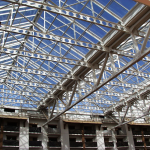How Cellular and Castellated Beams Are Revolutionizing Modern Construction
There is nothing quite like a building when it comes to modern beauty. It is a blend of form and function. It’s tangible art and beauty you can literally inhabit.
And just like any other form of art, it has experienced many changes. In recent decades, engineers and architects have come to appreciate both castellated and cellular beams in the construction of new buildings. From tiny offices to huge stadiums, these beams provide a great solution.
Keep reading to learn more about the history and practical uses of these two kinds of beams!
What is the Difference?
In order to appreciate how castellated and cellular beams are able to work together, you must first understand what makes them different. There are actually many different qualities that make each one unique from the other.
With castellated beams, the hexagonal shape of the opening hole is created by fabricating steel beams or columns. This typically creates very small openings that may require additional modification if you need to fit any larger items through.
Cellular beams, meanwhile, form circular openings at regular centers throughout the fabrication process. Therefore, the castellated beams have cuts made from half hexagonal lines running straight down the center before they are moved across and welded together. The cellular beams are cut with a double pass process before being separated, moved as needed, and then welded together.
There are different advantages to both castellated and cellular beams. Keep reading to discover what a few of them are!
Castellated Advantages
There are several reasons why so many people have relied on castellated steel beams for so long. One of the obvious benefits is that it is both light and strong, making it a very versatile solution when it comes to any kind of construction work.
On top of that, castellated beams are affordable and easy to assemble. Considering how many construction projects are at risk of going over schedule and budget, this cheap and easy solution is very desirable to many people.
A more subjective advantage of castellated beams is that they look appealing. Unlike other construction and architectural elements that designers try to hide, castellated beams are often left in highly visible places. There’s a reason for that. They simply look good!
Finally, castellated beams can very easily be cut down to the exact size than an engineer or architect needs. This gives you complete control over a project, letting you balance the need to handle heavy loads with the need to make sure the bill isn’t quite so heavy!
Cellular Advantages
Compared to castellated, cellular steel beams represent untapped potential for designers and have several unique advantages.
For example, one of the many advantages of cellular beams is the versatility. Cellular allows you to have consistent cell diameters within the same beam section, all without changing up your entire fabrication process or adding additional expenses. That combination of versatility with affordability is a major feature.
That versatility extends to the spacing of cells as well. Using cellular beams allow you to change spacing between limits of each beam and have more options when it comes to how you position your apertures. With a little planning, the cellular process also means you can have your secondary beam connections coincide with full web sections, reducing the amount of holes that need to be filled.
And speaking of infilling, cellular beams lets you use partial hole infills in support openings and other high shear areas instead of filling them in. This ultimately saves you time while freeing up more zones for service. Again, versatility meets saving money and time: it’s tough to beat this really potent combination!
Practical Uses of Cellular Beams
Now you know more about the difference of castellated and cellular beams as well as the unique advantages that each one has. However, you might be curious as to the practical uses for this technology!
As it turns out, there are quite a few modern uses for this innovative technology. For instance, many parking garages rely on castellated beams. This is because the builders can save up to fifteen percent compared to building it out of materials such as concrete, and the costs can be further reduced by allowing the erection of the beams onsite. Ultimately, the garage has the same versatility and safety benefits, but at a significant savings.
Cellular beams have become a very popular choice for building large structures like sports stadiums. One of the big reasons for this is that the cellular beams allow the economical construction of the tapered beams that modern stadiums require. This kind of flexible cellular geometry also allows designers to get creative and build structures that offer a perfect blend of aesthetics and function.
Castellated and cellular beams are especially handy in the construction of large, open-air office buildings. This is because engineers can easily increase the beam’s strength without being forced to add steel to it. In this sense, you can have it both ways: the long beams are handy for building larger structures, and they provide the sturdiness and strength you need while reducing the actual construction time.
Both castellated and cellular beams are handy in the construction of malls. It really comes down to the kind of mall you want. Castellated beams are arguably more suited to the kind of open-air mall that modern designers (and many modern consumers) prefer. However, cellular beams can offer more geometrical flexibility and versatility, which may be handier for indoor structures.
Conclusion
Castellated and cellular beams are the backbone of modern construction. They allow you to achieve the building appearance of your dreams while providing the strength and stability needed to bring that dream to life.
Each one has its own unique advantages. And between these two beams, you can definitely find an innovative beam and building technique that is ideal for you and your company!






